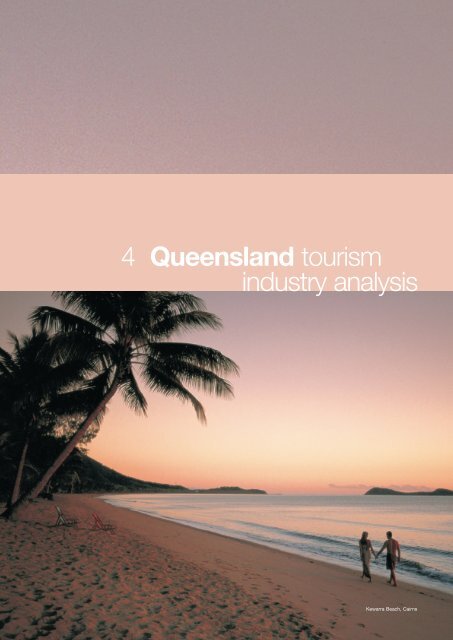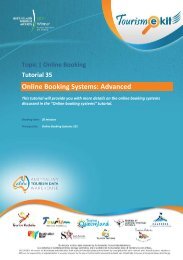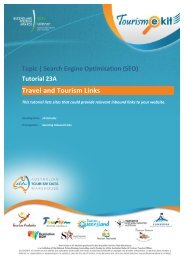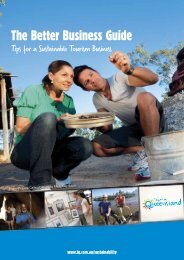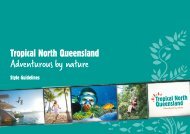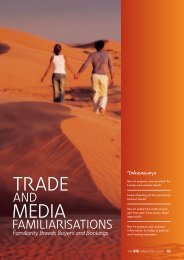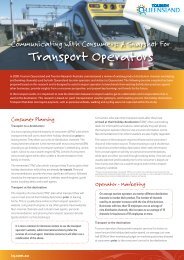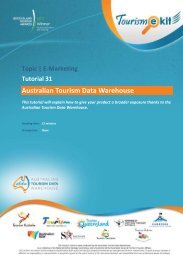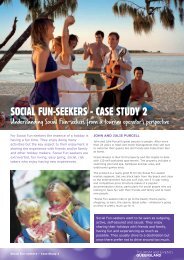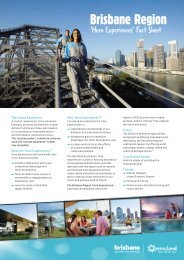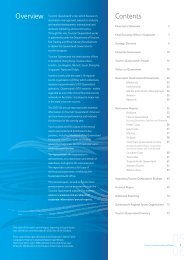industry analysis 4 Queensland tourism - Tourism Queensland
industry analysis 4 Queensland tourism - Tourism Queensland
industry analysis 4 Queensland tourism - Tourism Queensland
Create successful ePaper yourself
Turn your PDF publications into a flip-book with our unique Google optimized e-Paper software.
4 <strong>Queensland</strong> <strong>tourism</strong><br />
<strong>industry</strong> <strong>analysis</strong><br />
Kewarra Beach, Cairns
Trends and influences<br />
<strong>Tourism</strong> is subject to a range of global influences, events and forces that impact on the sustainability of the <strong>industry</strong> at statewide<br />
and regional levels. The diagram below outlines some of the issues and trends in the macro environment that may have an impact<br />
on <strong>tourism</strong> in <strong>Queensland</strong>.<br />
Economic trends<br />
• Fluctuating global economies and<br />
variable exchange rates will continue<br />
to influence travel demand<br />
• Variable fuel prices will influence<br />
transport supply and demand<br />
Political/legal trends<br />
• Terrorism will be ‘top of mind’ and<br />
travellers will adjust<br />
• Security measures will be standardised<br />
around the world and their cost will<br />
increase airfares<br />
4 Industry <strong>analysis</strong><br />
Natural environment trends<br />
• Environmental and social awareness<br />
will increase<br />
• Natural disasters and geo-political events<br />
affect travel behaviour<br />
Market trends<br />
• Increasing market fragmentation, and<br />
growth in special interest/niche markets<br />
• More frequent, shorter holidays<br />
• Travellers will have higher service<br />
expectations<br />
• More travellers will require customised<br />
holidays<br />
• Travellers will use new media technology<br />
more for information, booking and sales<br />
• Emerging travel markets in developing<br />
countries will influence travel demand<br />
• As baby boomers retire en masse from<br />
2010 to 2020, they will shape demand<br />
• Trend towards the accumulation of leave<br />
entitlements<br />
• Increased price sensitivity<br />
<strong>Tourism</strong><br />
Industry<br />
Technology trends<br />
• Technology will continue to develop at a<br />
rapid pace and involve all sectors of the<br />
<strong>industry</strong><br />
• Mobile phones will be used to plan and<br />
organise holidays<br />
• High-definition televisions and computers<br />
will provide virtual visits to a destination<br />
• Innovations in transportation will affect<br />
range, speed, comfort and safety of travel<br />
Industry trends<br />
• Liberalisation of air transport and low cost<br />
travel will influence travel demand<br />
• With greater speed and capacity, remote<br />
and long haul destinations will be more<br />
accessible<br />
and affordable to many travellers<br />
• Oversupply of undifferentiated travel<br />
products and destinations will affect<br />
competitiveness<br />
Competitive trends<br />
• A new hierarchy of destinations will take hold as Asia, the Pacific Islands and India<br />
become more popular<br />
• Competition among countries will be more intense<br />
• Regional economic agreements will facilitate travel within trade zones<br />
• <strong>Tourism</strong> will become a regional, rather than a global, phenomenon<br />
• More substitutes for travel<br />
Social & cultural trends<br />
• Growing urban and coastal populations<br />
• Ageing, affluent, active Western<br />
population<br />
• Emerging middle class in developing<br />
cities<br />
• Risk of a disease pandemic is growing<br />
• Growing concerns for safety and security<br />
Diagram 5: <strong>Tourism</strong> <strong>industry</strong> trends and influences<br />
19
4 Industry <strong>analysis</strong><br />
The impact of ‘peak oil’ and<br />
rising oil prices<br />
The QTS consultation process identified rising oil prices<br />
as a key <strong>industry</strong> concern. Between January 2000 and<br />
August 2006 the price of fuel in Brisbane increased 87<br />
per cent, from an average of 68 cents per litre to $1.29<br />
per litre. 8<br />
The Australian Association for the Study of Peak Oil<br />
(ASPO) has raised concerns that Australia’s principal<br />
foreign exchange earner, <strong>tourism</strong>, is particularly<br />
susceptible to rising fuel prices and the impact of ‘peak<br />
oil’ due to its dependence on long-distance air travel.<br />
‘Peak oil’ occurs when the world’s reserves of oil have<br />
been reduced by approximately half and fuel production<br />
falls into decline. When this will occur is the subject of<br />
much debate.<br />
Strengths, weaknesses,<br />
opportunities and threats <strong>analysis</strong><br />
An <strong>analysis</strong> of strengths, weaknesses, opportunities and threats<br />
(a SWOT <strong>analysis</strong>) provides insight into the internal capability of<br />
<strong>tourism</strong> in <strong>Queensland</strong> in relation to its competitors. It identifies<br />
the <strong>industry</strong>’s strengths, the opportunities for development and<br />
growth, the weaknesses that present obstacles to sustainable<br />
growth and the potential threats to the <strong>industry</strong>. Emerging from<br />
this <strong>analysis</strong> are the key challenges facing the <strong>industry</strong> (see the<br />
following SWOT <strong>analysis</strong>).<br />
The challenges identified through the SWOT <strong>analysis</strong> are<br />
consistent with the key issues identified through <strong>industry</strong><br />
consultation and are addressed within the action plans detailed<br />
in chapter six, Achieving our vision – making the difference.<br />
Rising fuel prices impact on both consumers and<br />
individual <strong>tourism</strong> businesses. For the consumer, higher<br />
fuel prices act to reduce disposable income and the<br />
ability to purchase travel products. From an economic<br />
perspective, rising operating costs and overheads<br />
affect the viability of <strong>tourism</strong> businesses.<br />
As a transport intensive business, <strong>tourism</strong> is highly<br />
sensitive to changes in fuel prices. This is particularly<br />
evident in aviation, where rising fuel costs contributed<br />
to the recent increase in fuel surcharges to cover<br />
operating costs.<br />
Rising fuel prices are of great concern for <strong>Queensland</strong><br />
destinations that rely on the drive <strong>tourism</strong> market. Drive<br />
<strong>tourism</strong> constitutes 75 per cent of all domestic travel in<br />
<strong>Queensland</strong> and is especially important to regional<br />
<strong>Queensland</strong> where up to 70 per cent of visitors arrive<br />
by car.<br />
The <strong>Queensland</strong> Government fuel subsidy of 8.3 cents<br />
per litre is helping define our State’s competitive<br />
advantage by cushioning the impact of rising fuel<br />
prices for motorists who take holidays in <strong>Queensland</strong>.<br />
For further information on peak oil, visit the Association for<br />
the Study of Peak Oil (ASPO), www.aspo-australia.org.au.<br />
Road to Horseshoe Bay, Bowen, Whitsundays<br />
8 FUELTRAC – www.fueltrac.com.au.<br />
20<br />
<strong>Queensland</strong> <strong>Tourism</strong> Strategy – November 2006
Spring blossum, Granite Belt, Stanthorpe<br />
SWOT Analysis<br />
STRENGTHS<br />
<br />
<br />
<br />
<br />
<strong>Tourism</strong>’s significant contribution to the <strong>Queensland</strong> economy<br />
Population growth driving infrastructure development<br />
<strong>Queensland</strong> perceived as a safe destination<br />
Good growth in domestic and international expenditure over five years<br />
<strong>Queensland</strong> is the most preferred domestic holiday destination for<br />
Australians<br />
Forecast high international growth to 2014<br />
<br />
<br />
<br />
<br />
<br />
<br />
<br />
Well-established brand in domestic markets<br />
<strong>Queensland</strong> is an aspirational brand overseas<br />
<strong>Queensland</strong> has abundant natural and built attractions<br />
<strong>Queensland</strong> has a wide range of holiday/leisure experiences<br />
Long established <strong>industry</strong> structure and RTO/LTO coordination structure<br />
Generally well-developed relationships between <strong>industry</strong> stakeholders<br />
with respect to marketing activities<br />
Low cost air access<br />
WEAKNESSES<br />
Importance of <strong>tourism</strong> not sufficiently recognised<br />
Standards and consistency in product and service quality vary<br />
Significant growth in outbound travel<br />
Flat growth in domestic visitation over five years<br />
Lack of investment in new serviced accommodation, new product,<br />
services and niche experiences<br />
Lack of resources for protected areas to ensure appropriate development<br />
Variable community support for <strong>tourism</strong> and awareness of value of <strong>tourism</strong><br />
Levels and quality of planning for <strong>tourism</strong> at local government level vary<br />
Non-systematic approach to assessing the costs and benefits of <strong>tourism</strong><br />
to local communities<br />
Lack of role clarity between various agencies<br />
Lack of coordination across federal, state, and local governments<br />
Shortage of skilled workforce<br />
Infrastructure may not be keeping pace with growth; adversely<br />
impacting on <strong>tourism</strong><br />
4 Industry <strong>analysis</strong><br />
OPPORTUNITIES<br />
Prospect of global political instability/safety and health risks overseas<br />
boosting domestic and inbound visitation<br />
Uncertain global and domestic economies impacting on travel choice<br />
and behaviour<br />
Changing demographics and family structure impacting on travel<br />
choices, needs and interests<br />
Population growth in South East <strong>Queensland</strong><br />
Increase in worldwide use of new technology<br />
Increased need for shorter, more frequent holidays – domestic<br />
Emerging international markets and opportunities for new business<br />
<br />
<br />
Increased desire for specialised / customised holiday experiences<br />
Low cost air travel and opportunities to increase inbound travel<br />
Greater consumer consciousness of destination safety, security and<br />
health issues<br />
New media technology and opportunity to reach new customers directly<br />
Innovations in transport technologies – range, speed, safety, comfort –<br />
bringing long haul markets closer<br />
Greater public awareness of, and interest in, sustainability and<br />
environmental issues<br />
THREATS<br />
Increasing oil and fuel prices<br />
Tougher competition from other markets<br />
Adverse impacts of <strong>tourism</strong> on the natural environment<br />
<br />
<br />
<br />
<br />
<br />
<br />
<br />
<br />
<br />
<br />
<br />
Adverse impacts of natural disasters on destination appeal and<br />
perceptions<br />
Falling quality of natural resources and attractions<br />
Innovation in communication technologies – could move quicker than<br />
we can match<br />
Lack of a strong <strong>tourism</strong> voice in government planning and policy forums<br />
Population and visitor growth putting pressure on public infrastructure<br />
Population expansion and residential development changing the<br />
character of <strong>Queensland</strong> experiences<br />
Higher expectations of product and service quality<br />
Low cost air travel and implications for outbound travel<br />
Low cost domestic air travel and implications for drive destinations<br />
Changing workplace dynamics/regulations impacting on leisure<br />
choices and behaviour<br />
Multiple destination approach to marketing may lead to a fragmentation<br />
of key messages<br />
Challenges<br />
<br />
Capitalise on <strong>Queensland</strong>’s international reputation as a safe<br />
destination while implementing crisis management plans to mitigate<br />
the impact of shocks<br />
<br />
Continue to encourage visitor expenditure by targeting new and<br />
emerging markets, while recognising that these same markets<br />
represent a growing competitive threat<br />
<br />
<br />
<br />
Facilitate investment in general and <strong>tourism</strong>-specific infrastructure to meet<br />
the needs of both a growing domestic population and the <strong>tourism</strong> <strong>industry</strong><br />
Maximise the benefits of low cost access by air to <strong>Queensland</strong>, while<br />
addressing the threat of increasing outbound travel<br />
Maximise the benefits of <strong>Queensland</strong>’s diverse products and strong<br />
multi-destination brand awareness, while ensuring that promotional<br />
messages are not fragmented<br />
<br />
<br />
Find opportunities to strengthen the <strong>tourism</strong> <strong>industry</strong>’s collective voice<br />
to encourage a greater recognition by decision makers of the <strong>industry</strong>’s<br />
contribution to the economy<br />
Capitalise on changing demographics and consumer travel choices<br />
and expectations by addressing weaknesses in service standards and<br />
the shortage in skilled labour<br />
21


